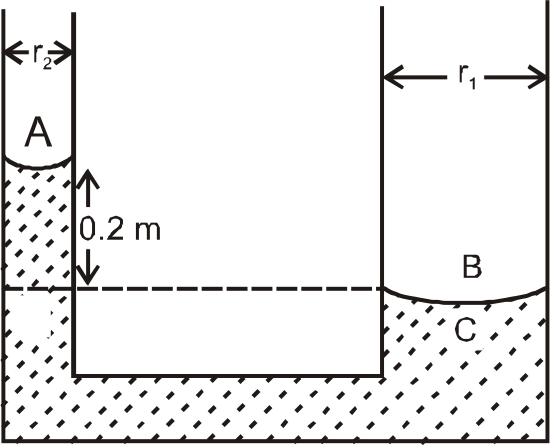A barometer contains two uniform capillaires of radii 1.44×10−3m and 7.2×10−3N/m and g=9.8m/s2.
Let the presures in wide and narrow limbs of P1 and P2, respectively. If R1 and R2 be the radii of meniscus in wide and narrow limb pressure just below hhe meniscus of wide tube =P1−2TR1 and pressure just below the meniscus of narrow limb =P2=2TR2.
Therefore, difference of these pressures
(P1−2TR1)−(P2−2TR2)=hρg
Therefore, true pressure difference,
P1−P2=hρg−2T(1R2−1R1)
For the water and glass surface, takingg in the angle of contact θ to be zero, we have R1=r1cosθ≈r1 and R2=r2cosθ≈r2 where r1 and r2 are radii of wide and narrow limbs, respectively.
∴P1−P2=hρg−2T(1r2−1r1)=0.2×103×9.8−2×72
×10−3×(17.2×10−4−11.44×10−3)
=1.96×103−0.10×103=1.86×103N/m2=1860N/m2
Topper's Solved these Questions
- BOOK - CENGAGE PHYSICS ENGLISHCHAPTER - PROPERTIES OF SOLIDS AND FLUIDSEXERCISE - Exercise 5.112videos
PROPERTIES OF SOLIDS AND FLUIDS
- BOOK - CENGAGE PHYSICS ENGLISHCHAPTER - PROPERTIES OF SOLIDS AND FLUIDSEXERCISE - Exercise 5.26videos
PROPERTIES OF SOLIDS AND FLUIDS
- BOOK - CENGAGE PHYSICS ENGLISHCHAPTER - PROPERTIES OF SOLIDS AND FLUIDSEXERCISE - INTEGER_TYPE2videos
PROPERTIES OF SOLIDS AND FLUIDS
- BOOK - CENGAGE PHYSICS ENGLISHCHAPTER - NEWTON'S LAWS OF MOTION 2EXERCISE - Integer type1videos
NEWTON'S LAWS OF MOTION 2
- BOOK - CENGAGE PHYSICS ENGLISHCHAPTER - RIGID BODY DYNAMICS 1EXERCISE - Integer11videos
RIGID BODY DYNAMICS 1
Similar Questions
A barometer contains two uniform capillaries of radii 1.4×10−3m and 7.2×10−4m. If the height of liquid in narrow tube is 0.2m more than that in wide tube, calculate the true pressure difference. Density of liquid =103kg/m3, surface tension =72×10−3N/m and g=9.8ms−12.
View SolutionA barometer contains two uniform capillries of radii 1.44×10−3m and 7.2×10−4m. If the height of the liquid in the narrow tube is 0.2m more than that in the wide tube, calculate the true pressure difference. Density of liquid =103kg/m3, surface tension =72×10−3N/m and g=m/s2.
View SolutionThe limbs of a manometer consists of uniform capillary tubes of radii 1.44×10−3m and 7.2×104m. If the level of the liquid in the narrower tube stands 0.2 m above that in the broader tube, pressure difference between A and B is found to be 310λN/m2. Here λ is an integer. Find λ (density = 103kg/m3, surface tension = 72×10−3N/m). (take g=9.8m/s2)
 View Solution
View SolutionA sonometer wire of length 1.5m is made of steel. The tension in it produces an elastic strain of 1%. What is the fundamental frequency of steel if density and elasticity of steel are 7.7×103kg/m3 and 2.2×1011N/m2 respectively ?
View SolutionA piano string 1.5m long is made of steel of density 7.7×103kg/m3andγ=2×1011N/m2. It is maintained at a tension which produces an elastic strain of 1% in the string . What is the fundamental frequency of transverse vibration of the string ?
View SolutionA piano string 1.5m long is made of steel of density 7.7×103kg/m3andγ=2×1011N/m2. It is maintained at a tension which produces an elastic strain of 1% in the string . What is the fundamental frequency of transverse vibration of the string ?
View SolutionThe rate of a reaction starting with initial concentration of 2×10−3 and 1×10−3M are equal to 2.40×10−4 and 0.60×10−4Ms−1, respectively. Calculate the order or reaction w.r.t. reactant and also the rate constant.
View SolutionFind the greatest length of steel wire that can hang vertically without breaking. Breaking stress of steel =8.0×108N/m2. Density of steel =8.0×103kg/m3. Take g=10m/s2.
View SolutionAt equilibrium, the concentrations of N2=3.0×10−3M,O2=4.2×10−3M, and NO=2.8×10−3M in a sealed vessel at 800K. What will be Kc for the reaction
N2(g)+O2(g)N2(g)+O2(g)⇔2NO(g)2NO(g)View SolutionCalculate the equilibrium constant (K) for the formation of NH^ in the following reaction: N2(g)+3H2(g)<⇒2NH3(g)
At equilibrium, the concentration of NH3, H2 and N2 are 1.2×10−2,3.0×10−2 and 1.5×10−2 M respectively.View Solution

